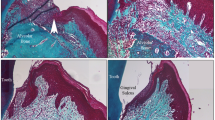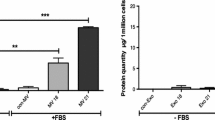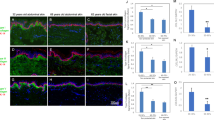Summary
Human skin wounds (n = 62) with a wound age between 5 h and 6 weeks were investigated. The appearance of cell-associated pericellular basement membrane components collagen type IV, laminin and heparan sulfate proteoglycan (HSPG) in myofibroblasts was evaluated by immunohistochemistry. Laminin and HSPG were first detectable around myofibroblasts approximately 1.5 days after wounding. Collagen type IV did not appear before the 4th day after wound infliction. In wounds more than 7 days old, 94% of the cases showed fibroblastic cells positively staining for laminin, 70% of the wounds contained fibroblastic cells positive for HSPG and in 63% a positive reaction for collagen type IV was obtained around these cells. The numbers of the cases as well as of the cells positively stained for laminin exceeded the corresponding values for HSPG and especially for collagen type IV. The pericellular appearance of laminin or HSPG around myofibroblasts, therefore, indicates a wound age of at least approximately 1.5 days. The pericellular localization of collagen type IV indicates a survival time of approximately 4 days or more. Since these proteins are still detectable in the pericellular region of myofibroblasts in skin wounds with advanced wound age (6 weeks) further information for the time-estimation of older human skin lesions cannot be obtained. A semiquantitative analysis revealed no significant correlation between the number of positively stained cells and the wound age, rendering this parameter unsuitable for a practicable time-estimation of human wounds.
Zusammenfassung
An insgesamt 62 menschlichen Hautwunden mit einer Überlebenszeit zwischen 5 Stunden und 6 Wochen wurde das wundaltersabhängige perizelluläre Auftreten der Basalmembran-Komponenten Kollagen Typ IV, Laminin und Heparansulfat-Proteoglycan (HSPG) in Myofibroblasten untersucht. Laminin und HSPG waren erstmals in einer 1,5 Tage überlebten Hautwunde nachweisbar, Kollagen IV konnte erst nach ca. 4 Tagen beobachtet werden. In Hautwunden mit einem Wundalter von 1 Woche und mehr konnte in 94% der Fälle Laminin, in 70% HSPG und in 63% Kollagen IV perizellulär nachgewiesen werden. Laminin trat hierbei nicht nur in einem höheren Prozentsatz der Fälle, sondern auch in einer größeren Anzahl von Myofibroblasten im Vergleich zu HSPG und v.a. zu Kollagen IV auf. Der positive Nachweis von Laminin oder HSPG bzw. von Kollagen IV in der perizellulären Region von Myofibroblasten weist somit auf ein Wundalter von mindestens ca. 1,5 bzw. 4 Tagen hin. Da die untersuchten Basalmembran-Komponenten auch noch um Myofibroblasten älterer Hautwunden (6 Wochen Wundalter) nachweisbar waren, kann durch die immunhistochemische Darstellung dieser Proteine keine zusätzliche Aussage über das Alter von Wunden mit längerer überlebenszeit getroffen werden. Die semiquantitative Auswertung ergab keine für eine Wundaltersbestimmung verwertbare Korrelation zwischen der Zahl positiv anfärbbarer Myofibroblasten und der überlebenszeit.
Similar content being viewed by others
References
Abrahamson DR (1986) Recent studies on the structure and pathology of basement membranes. J Pathol 149:257–278
Berg S, Elbel R (1969) Altersbestimmung subkutaner Blutungen. Münch Med Wochschr 111:1185–1190
Berg S (1972) Die Altersbestimmung von Hautverletzungen. Z Rechtsmed 70:121–135
Betz P, Nerlich A, Wilske J, Tübel J, Wiest I, Penning R, Eisenmenger W (1992) The time-dependent rearrangement of the epithelial basement membrane in human skin wounds — immunohistochemical localization of collagen type IV and VII. Int J Leg Med 105:93–97
Betz P, Nerlich A, Wilske J, Tübel J, Penning R, Eisenmenger W (1992) Time-dependent appearance of myofibroblasts in granulation tissue of human skin wounds. Int J Leg Med 105:99–103
Darby I, Skalli O, Gabbiani G (1990) Alpha-smooth muscle actin is transiently expressed by myofibroblasts during wound healing. Lab Invest 63:21–29
Eisenmenger W, Nerlich A, Glück G (1988) Die Bedeutung des Kollagens bei der Wundaltersbestimmung. Z Rechtsmed 100:79–100
Foidart JM, Bere EW, Yaar M, Rennard SI, Gullino M, Martin GR, Katz SI (1980) Distribution and immunoelectron microscopic localization of laminin, a non collagenous basement membrane glycoprotein. Lab Invest 42:336–342
Hsu SM, Raine L, Fanger H (1981) A comparative study of the peroxidase-antiperoxidase method and an avidin-biotin complex method for studying polypeptide hormones with radioimmunoassay antibodies. Am J Clin Pathol 75:743–739
Kühn K (1986) The collagen family — variations in the molecular and supermolecular structure. In: Kühn K, Krieg T (eds) Rheumatology — an annual review. Vol 10: Connective tissue: biological and clinical aspects. Karger, Basel Manchen Paris London New York New Delhi Singapore Tokyo Sidney
Martinez-Hernandez A, Ament PS (1983) The basement membrane in pathology. Lab Invest 48:656–677
Mueller B (1964) Zur Frage der Unterscheidung von vitalen bzw. agonalen und postmortalen Blutungen. Acta Med Leg Soc 17:43–46
Nerlich A, Haraida S, Backa D, Schleicher E, Betz P, Höfling B (1991) Immunhistochemische Analyse der extrazellulären Matrix zur Differentialdiagnose myogener und fibroblastdrer Zellproliferation. Verh Dtsch Ges Pathol 75:246
Sappino AP, Schürch W, Gabbiani G (1990) Biology of disease. Differentiation repertoire of fibroblastic cells: expression of cytoskeletal proteins as markers of phenotypic modulations. Lab Invest 63:144–161
Author information
Authors and Affiliations
Additional information
This study was supported by grants from the “Deutsche Forschungs-gemeinschaft” (grant Ei 209/3-1) and from the “Friedrich-BaurStiftung”, University of Munich, Germany
Rights and permissions
About this article
Cite this article
Betz, P., Nerlich, A., Wilske, J. et al. Time-dependent pericellular expression of collagen type IV, laminin, and heparan sulfate proteoglycan in myofibroblasts. Int J Leg Med 105, 169–172 (1992). https://doi.org/10.1007/BF01625171
Received:
Revised:
Issue Date:
DOI: https://doi.org/10.1007/BF01625171




